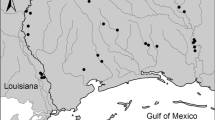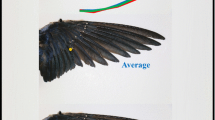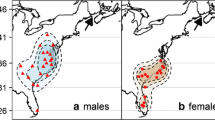Abstract
Contingent individual performance can depend on the environment experienced at previous life-stages. Migratory birds are especially susceptible to such carry-over effects as they periodically travel between breeding ranges and ‘wintering’ areas where they may experience broadly different ecological conditions. However, the study of carry-over effects is hampered by the difficulty of tracking vagile organisms throughout their annual life-cycle. Using information from light-level geolocators on the barn swallow (Hirundo rustica), we tested if feather growth bar width (GBW), a proxy of feather growth rate which depends on individual condition, and wing isometric size and shape predict the phenology of subsequent migration. GBW did not predict duration of wintering but negatively predicted the duration of spring migration and arrival date to the breeding sites, suggesting that migration phenology is not constrained by molt, and individuals in prime condition achieve both faster molt and earlier arrival. Wing morphology did not predict migration duration, as expected if wing shape were optimized for foraging, rather than migration performance, in this aerially foraging, insectivorous bird. Thus, we showed for the first time that migration phenology in a long-distance migratory bird covaries with body condition during wintering, as reflected by the growth rate of feathers.

Similar content being viewed by others
References
Altwegg R, Broms K, Erni B, Bernard P, Midgley G, Underhill LG (2012) Novel methods reveal shifts in migration phenology of barn swallows in South Africa. Proc R Soc Lond B 279:1485–1490
Bowlin MS, Wikelski M (2008) Pointed wings, low wing loading and calm air reduce migratory flight costs in songbirds. PLoS ONE 3:e2154
Bridge ES, Thorup K, Bowlin MS, Chilson PB, Diehl RH, Fleron RW, Hartl P, Kays R, Kelly JF, Roinson WD, Wikelski M (2011) Technology in the move: recent and forthcoming innovations for tracking migratory birds. Bioscience 61:689–698
Carrascal LM, Senar JC, Mozetich I, Uribe F, Domenech J (1998) Interactions among environmental stress, body condition, nutritional status, and dominance in great tits. Auk 115:727–738
Charmantier A, McCleery RH, Cole LR, Perrins C, Kruuk LEB, Sheldon BC (2008) Adaptive phenotypic plasticity in response to climate change in a wild bird population. Science 320:800–803
Corman A-M, Bairlein F, Schmaljohann H (2014) The nature of the migration routes shapes physiological traits and aerodynamic properties in a migratory songbird. Behav Ecol Sociobiol 68:391–402
Cramp S (1998) The complete birds of the Western Palearctic on CD-ROM. Oxford University Press, Oxford
DesRochers DW, Reed JM, Awerman J, Kluge JA, Wilkinson J, van Griethuijsen LI, Aman J, Romero LM (2009) Exogenous and endogenous corticosterone alter feather quality. Comp Biochem Physiol A 152:46–52
Ekman JA, Brodin A, Bylin A, Sklepkovych B (1996) Selfish long-term benefits of hoarding in the Siberian Jay. Behav Ecol 7:140–144
Fiedler W (2005) Ecomorphology of the external flight apparatus of blackcaps (Sylvia atricapilla) with different migration behaviour. Ann N Y Acad Sci 1046:253–263
Gienapp P, Merilä J (2010) Genetic and environmental effects on a condition-dependent trait: feather growth in Siberian jays. J Evol Biol 23:715–723
Grubb TC (1989) Ptilochronology: feather growth bars as indicators of nutritional status. Auk 106:314–320
Grubb TC (1991) A deficient diet narrows growth bars on induced feathers. Auk 108:725–727
Grubb TC (1995) Ptilochronology a review and prospectus. Curr Ornithol 12:89–114
Grubb TC (2006) Ptilochronology: feather time and the biology of birds. Oxford University Press, New York
Grubb TC, Woolfenden GE, Fitzpatrick JW (1998) Factors affecting nutritional condition of fledgling Florid Scrub-jays: a ptilochronology approach. Condor 100:753–756
Harrison XA, Blount JD, Inger R, Norris DR, Bearhop S (2011) Carry-over effects as drivers of fitness differences in animals. J Anim Ecol 80:4–18
Jenkins KD, Hawley DM, Farabaugh CS, Cristol DA (2001) Ptilochronology reveals differences in condition of captive White-throated Sparrows. Condor 103:579–586
Jenni L, Jenni-Eiermann S (1987) Herbstzug der Gartengrasmücke in der Schweiz. Ornithol Beob 84:173–206
Jenni L, Winkler R (1994) Moult and ageing of European passerines. Academic, London
Jovani R, Blas J, Navarro C, Mougeot F (2011) Feathers growth bands and photoperiod. J Avian Biol 42:1–4
Liechti F, Scandolara C, Rubolini D, Ambrosini R, Korner-Nievergelt F, Hahn S, Lardelli R, Romano M, Caprioli M, Romano A, Sicurella B, Saino N (2015) Timing of migration and residence areas during the non-breeding period of barn swallows Hirundo rustica in relation to sex and population. J Avian Biol. doi:10.1111/jav.00485
Lockwood R, Swaddle JP, Rayner JMV (1998) Avian wingtip shape reconsidered: wingtip shape indices and morphological adaptations to migration. J Avian Biol 29:273–292
McNamara JM, Houston A (2008) Optimal annual routines: behaviour in the context of physiology and ecology. Philos Trans R Soc Lond B 363:301–319
Møller AP, Fiedler W, Berthold P (2010) Effects of climate change on birds. Oxford University Press, Oxford
Newton I (2008) The migration ecology of birds. Academic, London
Newton I (2011) Migration within the annual cycle: species, sex and age differences. J Ornithol 152:S169–S185
Norris DR (2005) Carry-over effects and habitat quality in migratory populations. Oikos 109:178–186
Saino N, Szep T, Ambrosini R, Romano M, Møller AP (2004a) Ecological conditions during winter affect sexual selection and breeding in a migratory bird. Proc R Soc Lond B 271:681–686
Saino N, Szep T, Romano M, Rubolini D, Spina F, Møller AP (2004b) Ecological conditions during winter predict arrival date at the breeding quarters in a trans-Saharan migratory bird. Ecol Lett 7:21–25
Saino N, Romano M, Caprioli M, Ambrosini R, Rubolini D, Scandolara C, Romano A (2012) A ptilochronological study of carry-over effects of conditions during wintering on breeding performance in the barn swallow Hirundo rustica. J Avian Biol 43:513–524
Saino N, Romano M, Caprioli M, Lardelli R, Micheloni P, Scandolara C, Rubolini D, Fasola M (2013) Molt, feather growth rate and body condition of male and female barn swallows. J Ornithol 154:537–547
Saino N, Romano M, Rubolini D, Ambrosini R, Romano A, Caprioli M, Costanzo A, Bazzi G (2014) A trade-off between reproduction and feather growth in the barn swallow (Hirundo rustica). PLoS ONE 9:e96428
Scandolara C, Rubolini D, Ambrosini R, Caprioli M, Hahn S, Liechti F, Romano A, Romano M, Sicurella B, Saino N (2014) Impact of miniaturized geolocators on barn swallows (Hirundo rustica) fitness traits. J Avian Biol 45:417–423
Turner A (2006) The barn swallow. Poyser, London
White DW, Kennedy ED, Stouffer PC (1991) Feather regrowth in female European Starlings rearing broods of different sizes. Auk 108:889–895
Author information
Authors and Affiliations
Corresponding author
Additional information
Communicated by Hannu Pöysä.
Electronic supplementary material
Below is the link to the electronic supplementary material.
Rights and permissions
About this article
Cite this article
Saino, N., Rubolini, D., Ambrosini, R. et al. Light-level geolocators reveal covariation between winter plumage molt and phenology in a trans-Saharan migratory bird. Oecologia 178, 1105–1112 (2015). https://doi.org/10.1007/s00442-015-3299-1
Received:
Accepted:
Published:
Issue Date:
DOI: https://doi.org/10.1007/s00442-015-3299-1




